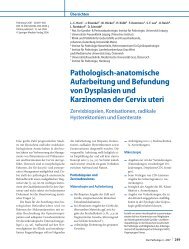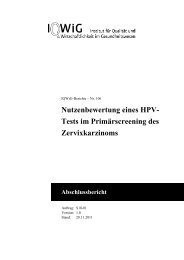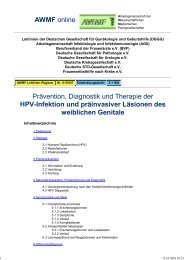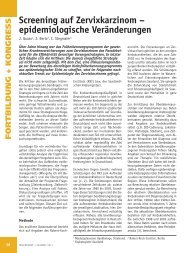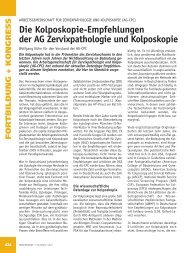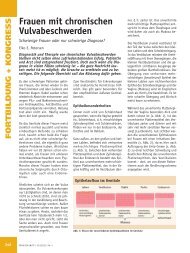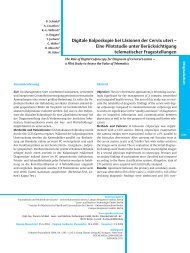2011 Terminology of the Vulva of the International Federation for ...
2011 Terminology of the Vulva of the International Federation for ...
2011 Terminology of the Vulva of the International Federation for ...
You also want an ePaper? Increase the reach of your titles
YUMPU automatically turns print PDFs into web optimized ePapers that Google loves.
helped to establish an ongoing dialog between representatives<br />
<strong>of</strong> <strong>the</strong> different disciplines in an attempt to<br />
arrive at an accepted nomenclature <strong>for</strong> diagnostic and<br />
<strong>the</strong>rapeutic procedures [2, 3].<br />
However, <strong>the</strong>re are more players in <strong>the</strong> field. Many<br />
women affected by diseases <strong>of</strong> <strong>the</strong> vulva are referred<br />
<strong>for</strong> care to colposcopy clinics. Colposcopists take care<br />
<strong>of</strong> women with abnormal Pap smears. However, <strong>the</strong>y<br />
are also experienced in treating human papillomavirus<br />
(HPV)Yrelated diseases and intraepi<strong>the</strong>lial neoplasia<br />
<strong>of</strong> <strong>the</strong> whole lower genital tract. They use <strong>the</strong><br />
colposcopeVa magnifying optical tool; <strong>the</strong>y are capable<br />
<strong>of</strong> documenting <strong>the</strong> lesions and are experienced<br />
in administering treatment by carbon dioxide (CO2) laser,<br />
dia<strong>the</strong>rmy, and cryo<strong>the</strong>rapy, which are appropriate<br />
<strong>the</strong>rapies <strong>for</strong> lower genital tract lesions. In addition,<br />
<strong>the</strong>re has recently been an increase in <strong>the</strong> incidence<br />
<strong>of</strong> <strong>the</strong> diagnosis <strong>of</strong> anal intraepi<strong>the</strong>lial neoplasia (AIN),<br />
a precursor <strong>of</strong> anal carcinoma [4]. The high-resolution<br />
anoscopy examination, used to detect intraepi<strong>the</strong>lial<br />
and invasive anal neoplasia, is basically colposcopy <strong>of</strong><br />
<strong>the</strong> anus, and <strong>the</strong> treatment <strong>of</strong> this precancerous anal<br />
condition also involves use <strong>of</strong> <strong>the</strong> CO2 laser, cryo<strong>the</strong>rapy,<br />
and o<strong>the</strong>r destructive modalities found in colposcopy<br />
clinics.<br />
Never<strong>the</strong>less, although colposcopists use <strong>the</strong> terminology<br />
<strong>of</strong> <strong>the</strong> <strong>International</strong> <strong>Federation</strong> <strong>for</strong> Cervical Pathology<br />
and Colposcopy (IFCPC) to report <strong>the</strong> cervical<br />
findings, <strong>the</strong>re was no IFCPC terminology <strong>for</strong> vulvar<br />
patterns (including <strong>the</strong> anal region) recognized during<br />
<strong>the</strong> clinical or <strong>the</strong> colposcopic examination [5]. Clinicians<br />
who tried to use <strong>the</strong> terminology <strong>for</strong> vulvar disease<br />
<strong>of</strong> <strong>the</strong> ISSVD, <strong>the</strong> guardian organization <strong>of</strong> vulvar<br />
diseases, found that it did not include pattern recognition<br />
terminology but was ra<strong>the</strong>r a classification according<br />
to disease pathophysiology [2, 3]. Hence, <strong>the</strong><br />
reporting <strong>of</strong> vulvar findings has been inconsistent.<br />
There<strong>for</strong>e, <strong>the</strong> IFCPC nomenclature committee, which<br />
was established at <strong>the</strong> 2008 IFCPC world congress in<br />
Auckland, New Zealand, took on itself <strong>the</strong> task <strong>of</strong> creating<br />
a comprehensive, ‘‘total’’ lower genital tract colposcopic<br />
terminology, not only <strong>of</strong> cervical and vaginal colposcopy<br />
findings [6] but also <strong>of</strong> <strong>the</strong> vulvar, perineal, perianal, and<br />
anal regions. For that purpose, a subcommittee to establish<br />
<strong>the</strong> terminology <strong>of</strong> vulvar conditions was set up,<br />
headed by Dr Jacob Bornstein, MD, MPA, which included<br />
doctors Mario Sideri, MD, and Hope Haefner, MD.<br />
The IFCPC current and presidents-electVDrs Patrick<br />
Walker, Silvio Tatti, and Walter PrendivilleValso participated<br />
in <strong>the</strong> deliberations. The discussions were<br />
IFCPC <strong>Vulva</strong> <strong>Terminology</strong> & 291<br />
carried out through a dedicated Web site, by e-mail,<br />
and at meetings. The vulvar (including <strong>the</strong> anal) clinical<br />
and colposcopic terminology was accepted by <strong>the</strong><br />
general assembly <strong>of</strong> <strong>the</strong> IFCPC at <strong>the</strong> <strong>2011</strong> World congress<br />
in Rio de Janeiro, Brazil, and was finalized in<br />
March 2012. The aim <strong>of</strong> <strong>the</strong> IFCPC was to create <strong>the</strong><br />
terminology that would take into account <strong>the</strong> new<br />
ISSVD vulvar terminology, as well as add terminologies<br />
specific to o<strong>the</strong>r regions and be compatible with colposcopy.<br />
There<strong>for</strong>e, only after <strong>the</strong> new ISSVD terminology<br />
was ready [7] did <strong>the</strong> IFCPC vulvar nomenclature subcommittee<br />
complete its deliberations.<br />
As <strong>the</strong> representative body <strong>of</strong> <strong>the</strong> national societies <strong>of</strong><br />
colposcopy and cervical pathology, <strong>the</strong> IFCPC recommends<br />
that <strong>the</strong> <strong>2011</strong> vulvar (including <strong>the</strong> anus) terminology<br />
be implemented without delay <strong>for</strong> diagnosis,<br />
treatment, and research purposes.<br />
THE STRUCTURE OF THE VULVAR TERMINOLOGY<br />
The vulvar terminology table includes several sections<br />
(Table 1).<br />
The first part is <strong>the</strong> section on basic definitions. It<br />
describes <strong>the</strong> various structures <strong>of</strong> <strong>the</strong> vulva and anus<br />
and <strong>the</strong>ir compositionVskin or mucosa. Although some<br />
conditions affect both skin and mucosa, many diseases<br />
are unique to <strong>the</strong> skin alone or to <strong>the</strong> mucosa alone. We<br />
fur<strong>the</strong>r divided <strong>the</strong> skin into ‘‘hairy’’ (e.g., labia majora)<br />
and ‘‘nonhairy’’ (e.g., clitoris), as hairy skin harbors<br />
skin appendages, which may be involved in a variety <strong>of</strong><br />
diseases, affecting <strong>the</strong>ir treatment, such as vulvar intraepi<strong>the</strong>lial<br />
neoplasia (VIN). This should affect <strong>the</strong><br />
consideration <strong>for</strong> excision <strong>of</strong> VIN in hair-bearing areas<br />
versus CO2 laser vaporization in nonYhair-bearing areas,<br />
<strong>for</strong> example.<br />
The normal findings section includes micropapillomatosis,<br />
sebaceous glands (Fordyce spots), and vestibular<br />
redness. As stated earlier, <strong>the</strong> rationale is to educate<br />
<strong>the</strong> clinicians that <strong>the</strong>se are normal findings. Vestibular<br />
redness alone is not a sign <strong>of</strong> dermatitis or inflammation.<br />
The remainder <strong>of</strong> <strong>the</strong> terminology table is composed<br />
<strong>of</strong> pattern recognition nomenclature that can be arrived<br />
at with or without a colposcope or a magnifying lens.<br />
Once <strong>the</strong> pattern has been recognized, fur<strong>the</strong>r evaluation<br />
and differential diagnosis may be carried out.<br />
The abnormal findings <strong>of</strong> <strong>the</strong> vulvar terminology include<br />
various variables that characterize each lesion by<br />
its size, location, type, color, and secondary morphology,<br />
if present. Because <strong>the</strong>se terms are novel to colposcopists,<br />
Tables 2 and 3 detail <strong>the</strong>ir definitions.<br />
Copyright © 2012 American Society <strong>for</strong> Colposcopy and Cervical Pathology. Unauthorized reproduction <strong>of</strong> this article is prohibited.




